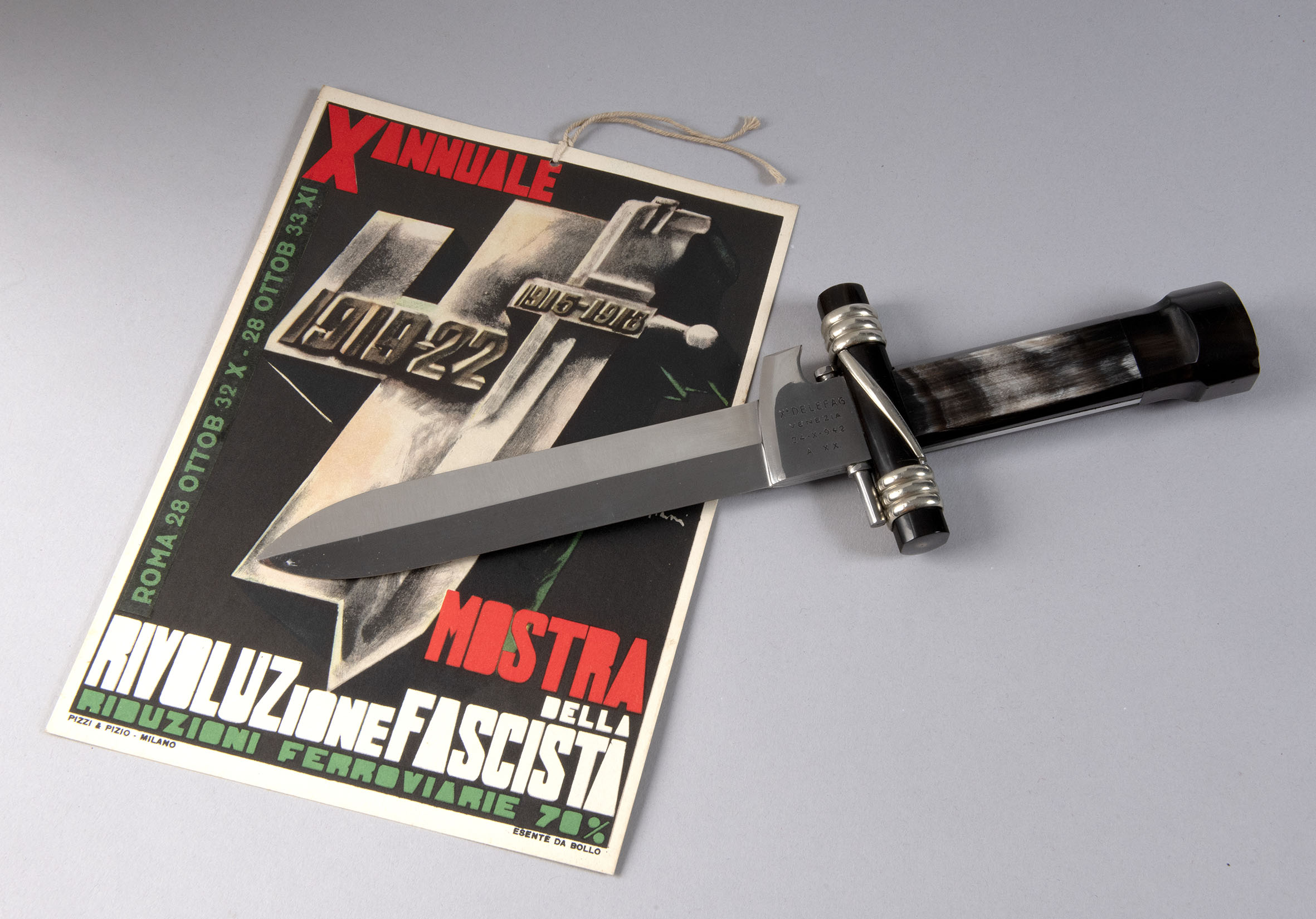Alessandro Pavolini’s Dagger
Sleek silver plated dagger with its crossguard and blade forming a lictoral fasces, a widely used symbol in Fascism from which the ideology derives its name. On the front of the ricasso forming the axe blade is inscribed “X a DELEFAG VENEZIA 24-X-942 A.XX.” Comes in the original presentation case with a dark blue silk-laid cover and silver dedication plaque reading “A.S.E. ALESSANDRO PAVOLINI” to whom the dagger was gifted. The acronym “A.S.E.” stands for A Sua Eccellenza (To His Excellency). The cryptic inscription on the blade can be deciphered as follows: “DELEFAG” is another acronym standing for Delegazioni Fabbriche di Guerra (War Factory Delegation), while “X a” signifies 10th and “24-X-942” the date October 24th, 1942. It can thus be deduced that this dagger was presented to minister Alessandro Pavolini by a delegation of the Italian war industry from the 10th territorial district of Venice at an event which took place on the 24th of October, 1942. At the time, much of northern Italy including Venice was under the administration of the notorious Italian Social Republic.
A refined essayist with degrees from the University of Florence and University of Rome, Alessandro Pavolini was the intellectual soul of Fascism. His commitment to Fascism was matched only by his brutality against its opponents, having joined a fascist paramilitary as a squadrista at seventeen, eventually ascending to become secretary of the Republican Fascist Party within the Italian Social Republic. Pavolini was feared by the Duce himself for his uncompromising fanaticism and is considered by historians to be a significant instigator behind the Italian Civil War between fascist hardliners and the monarcho-liberalist elements within the government who sought an armistice with Allies following the fall of Sicily. A man who embodied the most extreme within fascism, he fittingly shared his Duce’s fate, apprehended by partisans before being executed and hung upside down next to Mussolini in Milan.
Free shipping on orders over $50!
- Satisfaction Guaranteed
- No Hassle Refunds
- Secure Payments
Sleek silver plated dagger with its crossguard and blade forming a lictoral fasces, a widely used symbol in Fascism from which the ideology derives its name. On the front of the ricasso forming the axe blade is inscribed “X a DELEFAG VENEZIA 24-X-942 A.XX.” Comes in the original presentation case with a dark blue silk-laid cover and silver dedication plaque reading “A.S.E. ALESSANDRO PAVOLINI” to whom the dagger was gifted. The acronym “A.S.E.” stands for A Sua Eccellenza (To His Excellency). The cryptic inscription on the blade can be deciphered as follows: “DELEFAG” is another acronym standing for Delegazioni Fabbriche di Guerra (War Factory Delegation), while “X a” signifies 10th and “24-X-942” the date October 24th, 1942. It can thus be deduced that this dagger was presented to minister Alessandro Pavolini by a delegation of the Italian war industry from the 10th territorial district of Venice at an event which took place on the 24th of October, 1942. At the time, much of northern Italy including Venice was under the administration of the notorious Italian Social Republic.
A refined essayist with degrees from the University of Florence and University of Rome, Alessandro Pavolini was the intellectual soul of Fascism. His commitment to Fascism was matched only by his brutality against its opponents, having joined a fascist paramilitary as a squadrista at seventeen, eventually ascending to become secretary of the Republican Fascist Party within the Italian Social Republic. Pavolini was feared by the Duce himself for his uncompromising fanaticism and is considered by historians to be a significant instigator behind the Italian Civil War between fascist hardliners and the monarcho-liberalist elements within the government who sought an armistice with Allies following the fall of Sicily. A man who embodied the most extreme within fascism, he fittingly shared his Duce’s fate, apprehended by partisans before being executed and hung upside down next to Mussolini in Milan.







